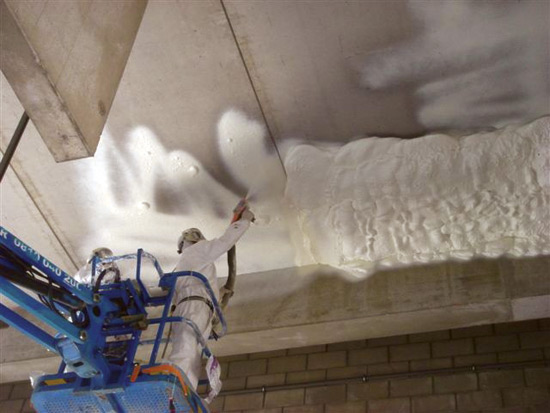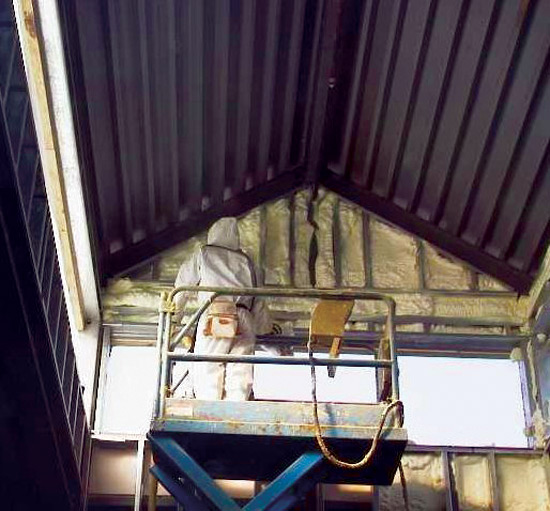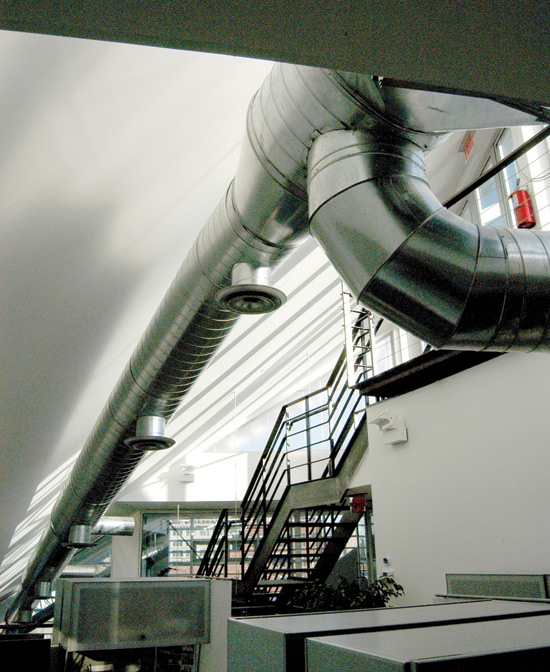Open Cell Spray Foam Insulation in Commercial Buildings
Open cell spray foam insulation effectively blocks heat transfer with a tested R-value of approximately R-3.5 to R-3.7 per inch. Its lower density gives it a comparatively softer make-up than denser closed cell insulation which means that it can seal around the edges and perimeter of stud cavities and any penetrations in a flexible manner. Some of the other benefits of open cell insulation are tied to this lighter, softer, and more flexible makeup. Acoustic control, for example, is enhanced in wall assemblies due to its sound-absorptive properties, more so than with rigid insulation. Should water infiltrate the assembly for any reason, its vapor permeability means that the material can dry both toward the interior and the exterior as may be preferred. As a material, it does not provide a food source for mold, meaning it won't grow in the insulation in a wall assembly. And the cost of open cell spray foam insulation is generally very attractive and competitive when compared to labor and materials for other types of insulations.
Low-density open cell spray foam insulation can be used in many common commercial building envelope locations such as exterior walls where it is sprayed from the inside against sheathing or roof/ceiling assemblies where it is similarly sprayed inside of sheathing or roof decks. It can also expand the horizon of better performance opportunities compared with fibrous or rigid board insulation options because of its inherent airtightness. This is particularly true in non-typical locations such as cathedral ceilings, domed ceilings, cantilevered floors, unconditioned space separations, arches, and other unusual shapes. Further, it is particularly good at filling in and sealing around irregularities in any of these locations such as plumbing, electrical, telecommunications and other service lines, junctions, or entry points.

Photo courtesy of ICYNENE, Inc.
Open cell, low-density spray foam insulation is applied in a continuous application against wall sheathing or roof decking.
When it comes to code compliance, many low-density spray foam products are approved for all construction types indicated in the International Building Code (IBC) including type I, II, III, IV, and V construction (check with the manufacturer for specific compliance details). Low-density spray foam can also be used in assemblies that require a fire rating and can meet specific IBC fire requirements for the use of plastics in wall assemblies. When used in framing cavities, the IBC is clear about requiring a protective barrier, designated as a thermal barrier, such as a layer of ½-inch gypsum board (or an intumescent coating) on interior surfaces. When it comes to attic spaces there is a little bit of ambiguity between the requirements for vented versus unvented attics. In vented attic spaces, the IBC currently requires spray foam to be covered with an ignition barrier which could be made from a number of possible materials. There are no specific provisions dealing with unvented attics although some light commercial buildings contain these spaces. Hence, an ignition barrier may or may not be required, subject to a specific architect's design or local building code interpretation. There is a general exception for products that have been tested and can show that they do not require an ignition barrier.
Integral Air Barrier Creates Optimal Building Performance
For commercial projects, open cell spray foam insulation delivers very high building performance by providing three distinct capabilities in a one-step application. First, it controls conductive heat flow through an assembly by virtue of its direct insulating value. This is enhanced by the fact that not only is the spray foam's tested R-value as good or better than most batt-type insulations, but a proper installation also fills completely all available spaces. In typical stud wall cavities, that means that irregularities from framing can be filled around rather than restricting or compromising the amount of insulation installed as may happen with rigid or batt-type insulation. R-values are also maintained over time since spray foam holds its shape such that sagging, settling, and other potential incomplete insulation installations that cause gaps or voids are not likely with spray foam insulation.

Photo courtesy of ICYNENE, Inc.
Spray foam insulation fills wall cavities completely and seals around irregular or complex shapes.
A second means of optimizing performance with open cell spray foam comes from its inherent ability to prevent air from flowing through it unlike fiberglass insulation which does allow air flow. This trait of the spray foam helps to eliminate convective heat currents and moisture flow in wall and ceiling cavities. Convection inside a framing cavity can reduce the effective R-value of a construction assembly and help draw unwanted moist air into framed areas. By eliminating this activity, performance is maintained and the damaging effects of moisture can be controlled or eliminated.

Photo courtesy of ICYNENE, Inc.
Spray foam insulation is commonly covered by a layer of gypsum board that has been painted with vapor retardant paint to meet code requirements for a vapor retarder where applicable.
Third, and perhaps as significant as R-values, is the ability of the open cell spray foam to act as a full, integral air barrier that controls air leakage into and out of construction assemblies and the building. In fact, spray foam insulation has been used in many buildings specifically to seal openings, penetrations, and gaps around doors and windows. Because of this air sealing quality, it can also be an effective barrier that minimizes airborne moisture transfer. Keeping unwanted moisture out of wall assemblies has long been a goal of successful design, thus these properties are significant. Its softer make-up compared to higher-density foams also means that it can flex and adjust to continue to provide an effective air seal even as the building may settle, expand, or contract over time.









